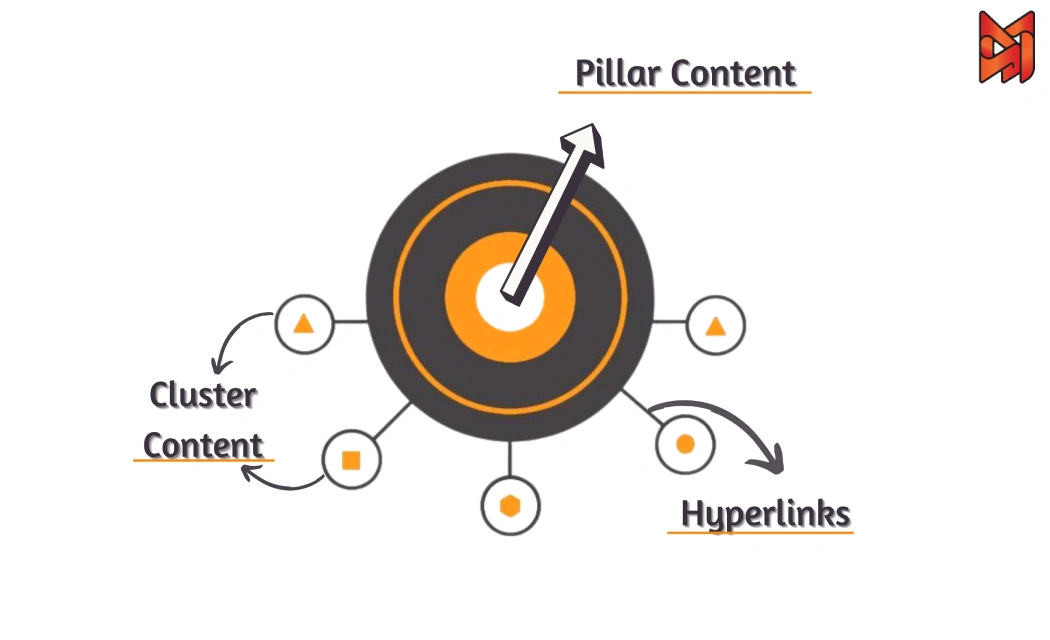In digital marketing, the content pillar is the backbone of an effective strategy, offering a structured way to organize, create, and distribute content that aligns with your brand’s goals. This article discusses the concept of content pillars’ structure, features, types, and their undeniable importance for brands. We’ll also cover examples, steps to creating them, and their role in social media success.
What Are Content Pillars?
Content pillars are the main topics or themes a brand focuses on in its content. They reflect the brand’s values and connect with its audience. Think of them as big categories that organize all the content a brand creates. Having clear content pillars helps keep the brand’s content consistent, engaging, and aligned with its goals. The content pillar also helps avoid orphan page , which isn’t good for SEO.
Structure of a Content Pillar
A well-designed content pillar typically follows this structure:
- Core Topic: The main subject around which all subtopics revolve.
- Cluster Content: Smaller, specific pieces of content that talks about aspects of the core topic.
- Internal Linking: Great connections between the core topic and cluster content to improve on page SEO and user experience.
- Call-to-Action (CTA): Prompts are messages or suggestions placed in key spots to encourage users to take specific actions, like signing up, buying something, or interacting with content.
If you want to write an effective content pillar for your website, consider our website content creation service. We specialize in creating content strategies that include comprehensive pillar-based frameworks based on your brand’s unique needs.
Features of Content Pillars
- Consistency: Keeps the brand message the same everywhere.
- Scalability: Makes it easy to create many topics and formats.
- SEO-Friendly: Helps more people find you online with the right keywords.
- Audience-Centric: Focuses on what the audience needs and cares about.

Pillar vs. Cluster Content: Understanding the Difference
- Pillar Content: This big, detailed piece of content gives an overview of a major topic and acts as the main hub for related content. It is often long and in-depth, covering all the key information someone might need about a topic. For example, an article like “The Complete Guide to Digital Marketing” could include SEO, social media marketing, email marketing, and paid advertising sections. It is a central resource that links to other, more specific pieces of content.
- Cluster Content: These are smaller, more specific pieces focusing on one part of the main topic. Cluster content supports the pillar by diving deeper into individual subtopics and linking to the main guide. For instance, supporting the digital marketing guide could be articles like “How to Use Email Marketing to Grow Your Small Business”, “Top Social Media Platforms for Marketers in 2025”, or “A Beginner’s Guide to SEO for E-commerce Websites.” Together, pillar and cluster content create a network of information that helps readers explore a topic thoroughly and improves SEO by linking related pages.
This structure makes it easier for users to find information and shows search engines that your site is a valuable resource on the topic.
The Importance of Content Pillars
Content pillars provide a roadmap for consistent, targeted, and purposeful content creation. They enable brands to:
- Build trust and credibility.
- Maintain consistency in messaging.
- Save Time and Effort: Make content creation easier and faster.
- Build a Loyal Audience: Attract people and keep them coming back.
- Get Clear Results: Set goals for each topic and track how well they work.
Types of Content Pillars
- Informative: Provides valuable knowledge and insights.
- Entertaining: Captures attention through fun and engaging content.
- Promotional: Drives sales and highlights offerings.
- Relational: Focuses on building connections and community.
- Newsworthy: Shares updates, trends, and industry developments.
- Values-Driven: Reflects your brand’s mission and beliefs.
Steps to Creating a Content Pillar
- Choose Main Topics: Pick big themes that are important to your brand and audience.
- Do Keyword Research: Use tools like Google Keyword Planner to find popular words people search for related to your topics.
- Plan Subtopics: Break the main topic into smaller, easy-to-understand parts.
- Make Quality Content: Create useful, interesting, and original content that gives real value to your audience.
- Link Content Together: Connect the smaller subtopics to the main topic using links within your website.
- Track Results: Check how your content is doing and make changes to improve it.
Why Content Pillars Are Essential for Your Brand
- Improved SEO: Content pillars improve website structure, enabling search engines to understand your content better.
- Stronger Brand Authority: Establishes your brand as a thought leader in your industry.
- Efficient Content Creation: Simplifies planning and ensures a steady flow of relevant content.
- Enhanced Audience Engagement: Keeps your audience informed and invested.
- Streamlined Collaboration: Teams can align on clear themes, making content planning and execution more efficient.

12 Examples of Content Pillars for Social Media
- Educational: Tutorials, how-to guides, and industry insights.
- Inspirational: Success stories, motivational quotes, and uplifting messages.
- Promotional: Product launches, sales, and special offers.
- User-Generated Content: Customer reviews, testimonials, and shared user photos.
- Behind-the-Scenes: A glimpse into your team, workspace, or creative process.
- Entertaining: Memes, quizzes, and relatable content.
- Thought Leadership: Expert opinions, interviews, and trend analyses.
- Seasonal: Holiday campaigns, themed posts, and timely topics.
- Community Involvement: Showcasing charity work, partnerships, or local events.
- FAQs: Addressing common questions from your audience.
- Interactive: Polls, challenges, and live Q&A sessions.
- Storytelling: Narratives about your brand’s journey or mission.
Sample Content Pillar for Social Media
Pillar: Sustainable Living
Cluster Content Ideas:
- How to Reduce Plastic Waste at Home
- 10 Easy Swaps for a Zero-Waste Lifestyle
- The Benefits of Using Reusable Products
- Real Stories from Eco-Friendly Communities
Execution on Social Media:
- Create an infographic on plastic reduction.
- Share a video tutorial on making DIY eco-friendly cleaning products.
- Post a poll asking followers about their favorite sustainable practices.
- Host a live session with sustainability experts to answer audience questions.
Final Thoughts
Making content pillars is a game-changer for any brand looking to establish authority, engage audiences, and drive results. By following the steps outlined above and covering the provided examples, you can create a powerful content strategy that connects with your audience and supports your business goals. If you want to implement content pillars, consider our content creation agency in dubai at DiMarketo. We specialize in creating content strategies that include comprehensive pillar-based frameworks tailored to your brand’s unique needs. Contact us today to revolutionize your content game.





